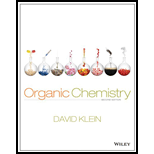
(a)
Interpretation:
Reagents should be predicted for the given transformations.
Concept introduction:
Reagent: reagent is a compound or compound mixture that is used in the chemical transformation of the reactions. Reagents for some reactions are given below.
- Elimination reaction: in elimination reaction, two substituents are removed from the substrate to give the product in presence of base.
- Anti-dihydroxylation: anti- dihydroxylation is a process of adding two –OH groups from different planes to the alkene.
Alkenes are treated with peroxy acids followed by aqueous acids and gives anti-dihydroxylation products. - Syn-dihydroxylation: syn- dihydroxylation is a process of adding two –OH groups from the same plane to the alkene. Potassium per manganite and osmium tetroxide etc, are used as reagents.
To find: the reagent for the given transformation.
(b)
Interpretation:
Reagents should be predicted for the given transformations.
Concept introduction:
Reagent: reagent is a compound or compound mixture that is used in the chemical transformation of the reactions. Reagents for some reactions are given below.
- Elimination reaction: in elimination reaction, two substituents are removed from the substrate to give the product in presence of base.
- Anti-dihydroxylation: anti- dihydroxylation is a process of adding two –OH groups from different planes to the alkene. Alkenes are treated with peroxy acids followed by aqueous acids and gives anti-dihydroxylation products.
- Syn-dihydroxylation: syn- dihydroxylation is a process of adding two –OH groups from the same plane to the alkene. Potassium per manganite and osmium tetroxide etc, are used as reagents.
To find: the reagent for the given transformation.
(c)
Interpretation:
Reagents should be predicted for the given transformations.
Concept introduction:
Reagent: reagent is a compound or compound mixture that is used in the chemical transformation of the reactions. Reagents for some reactions are given below.
- Elimination reaction: in elimination reaction, two substituents are removed from the substrate to give the product in presence of base.
- Anti-dihydroxylation: anti- dihydroxylation is a process of adding two –OH groups from different planes to the alkene. Alkenes are treated with peroxy acids followed by aqueous acids and gives anti-dihydroxylation products.
- Syn-dihydroxylation: syn- dihydroxylation is a process of adding two –OH groups from the same plane to the alkene. Potassium per manganite and osmium tetroxide etc, are used as reagents.
To find: the reagent for the given transformation.
(d)
Interpretation:
Reagents should be predicted for the given transformations.
Concept introduction:
Reagent: reagent is a compound or compound mixture that is used in the chemical transformation of the reactions. Reagents for some reactions are given below.
- Elimination reaction: in elimination reaction, two substituents are removed from the substrate to give the product in presence of base.
- Anti-dihydroxylation: anti- dihydroxylation is a process of adding two –OH groups from different planes to the alkene. Alkenes are treated with peroxy acids followed by aqueous acids and gives anti-dihydroxylation products.
- Syn-dihydroxylation: syn- dihydroxylation is a process of adding two –OH groups from the same plane to the alkene. Potassium per manganite and osmium tetroxide etc, are used as reagents.
To find: the reagent for the given transformation.
Want to see the full answer?
Check out a sample textbook solution
Chapter 9 Solutions
Organic Chemistry
 ChemistryChemistryISBN:9781305957404Author:Steven S. Zumdahl, Susan A. Zumdahl, Donald J. DeCostePublisher:Cengage Learning
ChemistryChemistryISBN:9781305957404Author:Steven S. Zumdahl, Susan A. Zumdahl, Donald J. DeCostePublisher:Cengage Learning ChemistryChemistryISBN:9781259911156Author:Raymond Chang Dr., Jason Overby ProfessorPublisher:McGraw-Hill Education
ChemistryChemistryISBN:9781259911156Author:Raymond Chang Dr., Jason Overby ProfessorPublisher:McGraw-Hill Education Principles of Instrumental AnalysisChemistryISBN:9781305577213Author:Douglas A. Skoog, F. James Holler, Stanley R. CrouchPublisher:Cengage Learning
Principles of Instrumental AnalysisChemistryISBN:9781305577213Author:Douglas A. Skoog, F. James Holler, Stanley R. CrouchPublisher:Cengage Learning Organic ChemistryChemistryISBN:9780078021558Author:Janice Gorzynski Smith Dr.Publisher:McGraw-Hill Education
Organic ChemistryChemistryISBN:9780078021558Author:Janice Gorzynski Smith Dr.Publisher:McGraw-Hill Education Chemistry: Principles and ReactionsChemistryISBN:9781305079373Author:William L. Masterton, Cecile N. HurleyPublisher:Cengage Learning
Chemistry: Principles and ReactionsChemistryISBN:9781305079373Author:William L. Masterton, Cecile N. HurleyPublisher:Cengage Learning Elementary Principles of Chemical Processes, Bind...ChemistryISBN:9781118431221Author:Richard M. Felder, Ronald W. Rousseau, Lisa G. BullardPublisher:WILEY
Elementary Principles of Chemical Processes, Bind...ChemistryISBN:9781118431221Author:Richard M. Felder, Ronald W. Rousseau, Lisa G. BullardPublisher:WILEY





